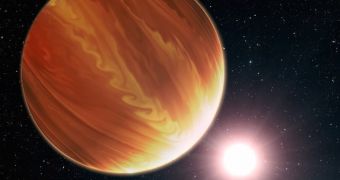Just yesterday, folks at the Space Telescope Science Institute in the US announced that, while studying three planets not far from Earth, they found these celestial bodies to be mind-bogglingly dry.
Simply put, the planets, known to the scientific community as HD 189733b, HD 209458b, and WASP-12b, were found to accommodate for far less water in their atmospheres than astronomers expected to find.
In a press release concerning this investigation and its outcome, researchers with the Space Telescope Science Institute detail that the three planets sit at a distance of about 60 to 900 light-years away from Earth.
Previous investigations have shown them to be gaseous worlds whose surface temperatures range from 1,500 degrees Fahrenheit to a whopping 4,000 degrees Fahrenheit (approximately 815 degrees Celsius to 2,204 degrees Celsius).
Based on this information and also taking into account existing planet-formation theories, astronomers expected to find quite a lot of vaporized water floating about in these three planet's atmospheres. However, this was not the case.
On the contrary, the Space Telescope Science Institute scientists say that, while studying the makeup of HD 189733b, HD 209458b, and WASP-12b with the help of NASA's Hubble Space Telescope, they found less vaporized water than estimated.
In a nutshell, the three planets were found to accommodate for about one-tenth to one-thousandth the expected volume of water in their atmospheres. Hence, astronomers are now thinking that it might not be such a bad idea to review planet-formation theories.
“It basically opens a whole can of worms in planet formation. We expected all these planets to have lots of water in them. We have to revisit planet formation and migration models of giant planets, especially ‘hot Jupiters,’ and investigate how they're formed,” says Dr. Nikku Madhusudhan.
This discovery is expected to also influence the quest to find alien life forms on planets that, at least at a first glance, appear to greatly resemble our good old Earth. Specifically, the find will likely add a question mark to existing theories concerning water availability on Earth-like planets.
“We should be prepared for much lower water abundances than predicted when looking at super-Earths (rocky planets that are several times the mass of Earth),” says Dr. Nikku Madhusudhan, the leader of this investigation into the water content of HD 189733b, HD 209458b, and WASP-12b's atmospheres.
“There are so many things we still don't know about exoplanets, so this opens up a new chapter in understanding how planets and solar systems form. What our study has shown is that water features could be a lot weaker than our expectations,” adds specialist Drake Deming.

 14 DAY TRIAL //
14 DAY TRIAL //